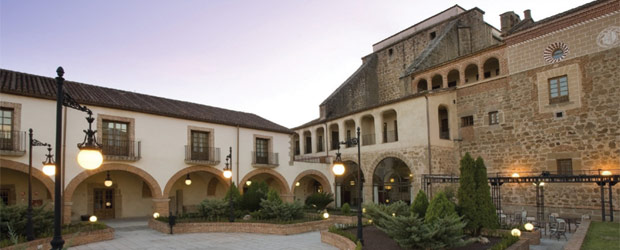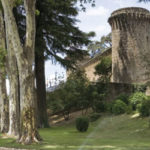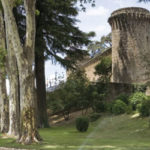Monastic Splendour On The Silver Route
Ancient Architectural Gems
Ages before the construction of this majestic monastery, monks were already residing behind the Parish church of San Miguel in what was once called The Santo Domingo Viejo. The community’s relocation to the new monastery took place while Fray Alfonso Maldonado was friar in 1477. Historians have traditionally attributed their sacred miracles to Saint Vincent Ferrer, who resuscitated the sole male child the duke and dutchess had. The monastery was severely damaged in the War of 1812, in which Spain fought for its independence from Napolean. It was reconstructed and renovated in 1850. Over the years it was occupied by various religious orders. The Fathers of Heart and Maria and the Servitas, were the last theological orders to occupy it.
[nggallery id=33]
The remains of the fortifications were found during archaeological research while carrying out the restoration of the building and it was confirmed that the Parador de Santo Domingo was a former fortress. Additionally, the area possessed a Sefardic synagogue and a Hebrew faith graveyard. Many artifacts had been found including a yad which is a pointer for reading, fragments of a hanukiyot which is a votive lamp and thus confirmed the existence of a significant Sefardic settlement in this area. The presence of human life in the area dates back into the remote past has been proven and a series of structures were partially built in caves.
Construction work on the monastery was directed by the master stone mason Pedro Gonzalez with the assistance of his son Francisco and the master craftsmans Maluenes, Dara and Garcia Escalante, who also collaborated on the two Plasencia Cathedrals.
The Monastery Complex
The 66 room Parador Hotel complex located in a small cosmopolitan city that flirts with all who encounter its treasures, is centered around the church which is almost cathedral like in proportions. The temple is reached through a large 17th century neo classical façade. Access to visit the the monastery complex is located on the Westside at an 18th century portico.
The Cloisters & Chapel Houses
The stunning proportioned cloister is late Gothic. The Profundis chapel was a most important room of its day and the star ribbed vaults date back to the 15th century.
Monumental 1577 Staircase In The Tapas Bar
The monumental staircase commonly called the Staircase of Air is especially noteworthy. It was built by Plasencia native Juan Alvarez in 1577. This architectural wonder rises without pillars, hanging almost in the air in a faultless study of thrust and executed with exceptional mastery.
The Wine Cellar, Bar De Copas & Chillout Lounge
The Hotel Parador ’s wine cellar, which dates back to the 15th century has been adapted to the needs of the 21st millennium guest however, it has been preserved virtually in its original state, with its embedded earthenware jugs, stone, bricks and ceiling vault. The perfect place to enjoy a wine or cocktail and enjoy the conversational background music.
Room 320 & Room 222
Firstly, Director Felix Lobo showed us ROOM 320, which houses the original walls of the Convent of Santo Domingo. The VIPS unique suite consists of 78 m2 and is divided into two large rooms each of which has its own cosy lounge to ensure maximum unwinding. The deep cherry red and white upholstery, period furniture and the fireplace all add to the warmth and romance of this suite. Our hotel ROOM 222 was absolutely a perfect place to spend a couple of nights. The wide ranging balcony views over the Gredos Mountain Range, pool, gardens and courtyard are divine.
Chef Luis Mora
- Mar : What is your culinary philosophy ?
- Luis: Adapting quality traditional products of the zone with modern concepts, reinterpretation and author creativity.
- Mar: Where have you studied ?
- Luis: I have been learning all my life as I was born into a family of chefs . My formal studies have been with the Parador Network. I have worked in the Parador Hotels of Chinchon, Antequera, Málaga, Hostería Del Estudiante in Alcalá de Henares and since October 2000 in the Parador of Plasencia.
- Mar: Your dream trip.
- Luis: The profound depths of Spain in all its regions.
- Mar: Tell us about autumn.
- Luis: Venison and wild hoofed game varieties, lamb, saffron, wild mushrooms Bolteus Eduli, Niscalos, chestnuts for desserts and red wine Tentudia from Almendralejos, Badajóz. I also employ some historic Sefardic ingredients.
- Mar: Your inspiration is derived from ?
- Luis: I read a lot, plus collaborate recipes with Juan Marí Arzak and Dani García.
Chef Luis Mora Savours Spanish Culture
- White wine: Sánz Clásico Rueda 2009
- Red wine: 50% Cabernet Sauvignon & 50% Tempranillo Tentudia 2005
- Torta del Casar sheepcheese & straight out of the oven assorted breads
- Palate cleanser French greenbean slaw & prawn salad
- The exquisite black cherry gazpacho
- Divine roast lamb with criadillas, Plasencia´s local potatoes
- Tecula Mecula: an ancient Roman almond gel concoction translating: For you, for me
- Sweet ripe stuffed fresh figs: D.O. Almohain, Cáceres
- Cañas: pastries with white chocolate filling
- Cherry sherbert
Hotel Parador Santo Domingo Convent
Plaza San Vincente Ferrer S.N.
Plasencia, Caceres 10600



